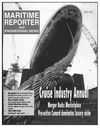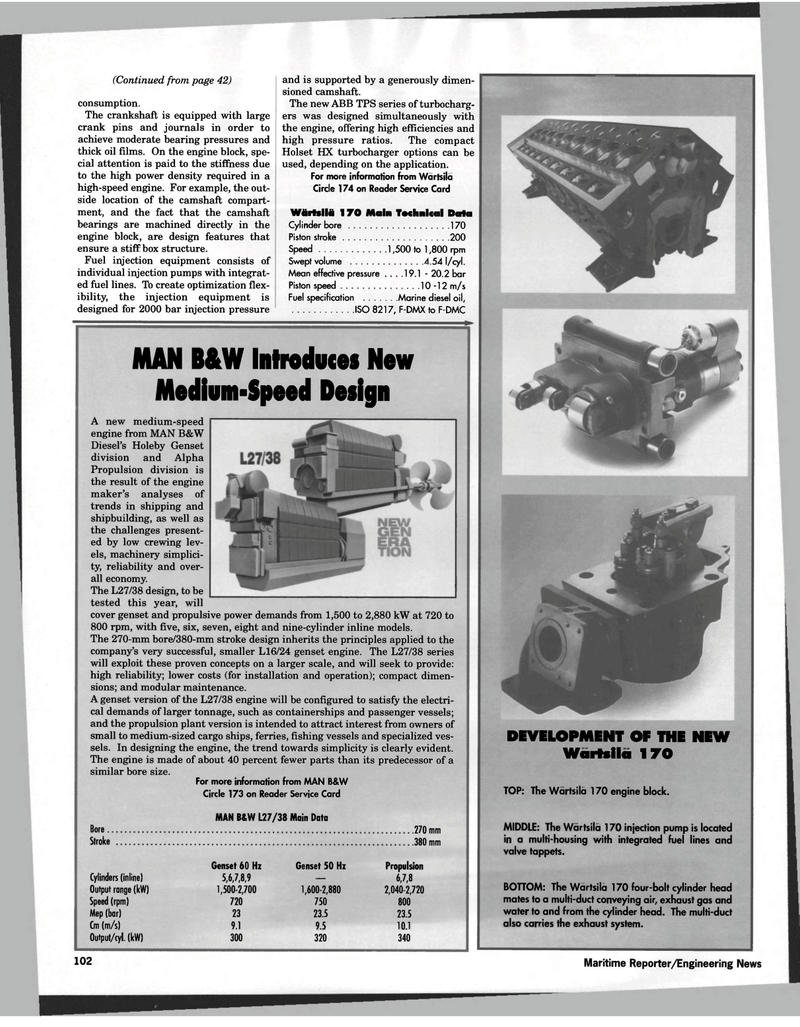
Page 102: of Maritime Reporter Magazine (July 1997)
Read this page in Pdf, Flash or Html5 edition of July 1997 Maritime Reporter Magazine
(Continued from page 42) consumption.
The crankshaft is equipped with large crank pins and journals in order to achieve moderate bearing pressures and thick oil films. On the engine block, spe- cial attention is paid to the stiffness due to the high power density required in a high-speed engine. For example, the out- side location of the camshaft compart- ment, and the fact that the camshaft bearings are machined directly in the engine block, are design features that ensure a stiff box structure.
Fuel injection equipment consists of individual injection pumps with integrat- ed fuel lines. To create optimization flex- ibility, the injection equipment is designed for 2000 bar injection pressure and is supported by a generously dimen- sioned camshaft.
The new ABB TPS series of turbocharg- ers was designed simultaneously with the engine, offering high efficiencies and high pressure ratios. The compact
Holset HX turbocharger options can be used, depending on the application.
For more information from Wartsila
Circle 174 on Reader Service Card
Wttrtsilfi 170 Main Technical Data
Cylinder bore 0
Piston stroke 20
Speed 1,500 to 1,800 rpm
Swept volume 4.54 l/cyl.
Mean effective pressure ... .19.1 - 20.2 bar
Piston speed 10 -12 m/s
Fuel specification Marine diesel oil,
ISO 8217, F-DMX to F-DMC
MAN B&W Introduces New
Medium-Speed Design
A new medium-speed engine from MAN B&W
Diesel's Holeby Genset division and Alpha
Propulsion division is the result of the engine maker's analyses of trends in shipping and shipbuilding, as well as the challenges present- ed by low crewing lev- els, machinery simplici- ty, reliability and over- all economy.
The L27/38 design, to be tested this year, will cover genset and propulsive power demands from 1,500 to 2,880 kW at 720 to 800 rpm, with five, six, seven, eight and nine-cylinder inline models.
The 270-mm bore/380-mm stroke design inherits the principles applied to the company's very successful, smaller L16/24 genset engine. The L27/38 series will exploit these proven concepts on a larger scale, and will seek to provide: high reliability; lower costs (for installation and operation); compact dimen- sions; and modular maintenance.
A genset version of the L27/38 engine will be configured to satisfy the electri- cal demands of larger tonnage, such as containerships and passenger vessels; and the propulsion plant version is intended to attract interest from owners of small to medium-sized cargo ships, ferries, fishing vessels and specialized ves- sels. In designing the engine, the trend towards simplicity is clearly evident.
The engine is made of about 40 percent fewer parts than its predecessor of a similar bore size.
For more information from MAN B&W
Circle 173 on Reader Service Card
Bore..
Stroke
MAN B&W L27/38 Main Data .270 mm .380 mm
Genset 60 Hz Genset 50 Hz Propulsion
Cylinders (inline) 5,6,7,8,9 — 6,7,8
Output range (kW) 1,500-2,700 1,600-2,880 2,040-2,720
Speed (rpm) 720 750 800
Mep (bar) 23 23.5 23.5
Cm (m/s) 9.1 9.5 10.1
Output/cyl. (kW) 300 320 340
DEVELOPMENT OF THE NEW
Wartsila 1TO
TOP: The Wartsila 170 engine block.
MIDDLE: The Wartsila 170 injection pump is located in a multi-housing with integrated fuel lines and valve tappets.
BOTTOM: The Wartsila 170 four-bolt cylinder head mates to a multi-duct conveying air, exhaust gas and water to and from the cylinder head. The multi-duct also carries the exhaust system. 102 Maritime Reporter/Engineering News

 101
101

 103
103
